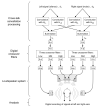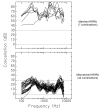The binaural performance of a cross-talk cancellation system with matched or mismatched setup and playback acoustics
- PMID: 17348528
- PMCID: PMC3561850
- DOI: 10.1121/1.2404625
The binaural performance of a cross-talk cancellation system with matched or mismatched setup and playback acoustics
Abstract
Cross-talk cancellation is a method for synthesizing virtual auditory space using loudspeakers. One implementation is the "Optimal Source Distribution" technique [T. Takeuchi and P. Nelson, J. Acoust. Soc. Am. 112, 2786-2797 (2002)], in which the audio bandwidth is split across three pairs of loudspeakers, placed at azimuths of +/-90 degrees, +/-15 degrees, and +/-3 degrees, conveying low, mid, and high frequencies, respectively. A computational simulation of this system was developed and verified against measurements made on an acoustic system using a manikin. Both the acoustic system and the simulation gave a wideband average cancellation of almost 25 dB. The simulation showed that when there was a mismatch between the head-related transfer functions used to set up the system and those of the final listener, the cancellation was reduced to an average of 13 dB. Moreover, in this case the binaural interaural time differences and interaural level differences delivered by the simulation of the optimal source distribution (OSD) system often differed from the target values. It is concluded that only when the OSD system is set up with "matched" head-related transfer functions can it deliver accurate binaural cues.
Figures













Comment on
-
Optimal source distribution for binaural synthesis over loudspeakers.J Acoust Soc Am. 2002 Dec;112(6):2786-97. doi: 10.1121/1.1513363. J Acoust Soc Am. 2002. PMID: 12508999
Similar articles
-
Sound localization in individualized and non-individualized crosstalk cancellation systems.J Acoust Soc Am. 2013 Apr;133(4):2055-68. doi: 10.1121/1.4792355. J Acoust Soc Am. 2013. PMID: 23556576
-
Acoustic and perceptual effects of magnifying interaural difference cues in a simulated "binaural" hearing aid.Int J Audiol. 2018 Jun;57(sup3):S81-S91. doi: 10.1080/14992027.2017.1308564. Epub 2017 Apr 10. Int J Audiol. 2018. PMID: 28395561
-
Speech perception, localization, and lateralization with bilateral cochlear implants.J Acoust Soc Am. 2003 Mar;113(3):1617-30. doi: 10.1121/1.1539520. J Acoust Soc Am. 2003. PMID: 12656396
-
[Sound localization cues of binaural hearing].Laryngorhinootologie. 2003 Apr;82(4):240-8. doi: 10.1055/s-2003-38932. Laryngorhinootologie. 2003. PMID: 12717598 Review. German.
-
Perceptual restoration of obliterated sounds.Psychol Bull. 1984 Sep;96(2):371-83. Psychol Bull. 1984. PMID: 6385048 Review. No abstract available.
Cited by
-
An Extended Binaural Real-Time Auralization System With an Interface to Research Hearing Aids for Experiments on Subjects With Hearing Loss.Trends Hear. 2018 Jan-Dec;22:2331216518800871. doi: 10.1177/2331216518800871. Trends Hear. 2018. PMID: 30322347 Free PMC article. Review.
-
The detection of differences in the cues to distance by elderly hearing-impaired listeners.J Acoust Soc Am. 2007 Feb;121(2):1077-89. doi: 10.1121/1.2404927. J Acoust Soc Am. 2007. PMID: 17348530 Free PMC article.
-
Sound Externalization: A Review of Recent Research.Trends Hear. 2020 Jan-Dec;24:2331216520948390. doi: 10.1177/2331216520948390. Trends Hear. 2020. PMID: 32914708 Free PMC article. Review.
-
Update to the dataset of cerebral ischemia in juvenile pigs with evoked potentials.Sci Data. 2021 Sep 23;8(1):248. doi: 10.1038/s41597-021-01029-z. Sci Data. 2021. PMID: 34556666 Free PMC article.
-
Estimating Cochlear Implant Users' Sound Localization Abilities With Two Loudspeakers.Trends Hear. 2025 Jan-Dec;29:23312165251340864. doi: 10.1177/23312165251340864. Epub 2025 May 14. Trends Hear. 2025. PMID: 40368405 Free PMC article.
References
-
- Akeroyd MA. [last viewed November 6, 2006];A binaural cross-correlogram toolbox for MATLAB. 2001 software downloadable from http://www.ihr.gla.ac.uk/products/matlab.php.
-
- Akeroyd MA, Summerfield Q. The lateralization of simple dichotic pitches. J. Acoust. Soc. Am. 2000;108:316–334. - PubMed
-
- Algazi VR, Duda RO, Thompson DM. The CIPIC HRTF database. Proceedings of the 2001 IEEE Workshop on Applications of Signal Processing to Audio and Electronics; New Paltz, New York: 2001. pp. 99–102.
-
- Atal BS, Schroeder MR. US Patent #3236949. Apparent Sound Source Translator. 1962 [reviewed in J. Acoust. Soc. Am. 41, 263-264 (1967)]
-
- Bai MR, Tung CW, Lee CC. Optimal design of loudspeaker arrays for robust cross-talk cancellation using the Taguchi method and the genetic algorithm. J. Acoust. Soc. Am. 2005;117:2802–2813. - PubMed
Publication types
MeSH terms
Grants and funding
LinkOut - more resources
Full Text Sources
Miscellaneous

